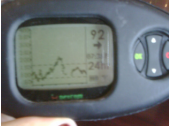Victoza for People with Type 1 Diabetes?
By Kelly Close
 by kelly close
by kelly close
In my 24 years with type 1 diabetes, things have gotten better each year. There were great years – when rapid-acting insulin analogs were invented; when lancets changed from 25 gauge to 27 (and then 31!); when I finally realized how great wearing a pump would be; when next-gen CGM emerged – and other years when the improvements were quite small. But the trend line has always been for the better.
So I’m not really sure why this year the whole diabetic enterprise has been harder than usual. My frustration is growing. I’m more tired. I’m trying to fix things more. My blood sugar is too high, then too low, then too high.
One of my worst moments occurred when my five-year-old, Coco, was telling her friend a secret. They were in the back of the car, and Coco leaned over and whispered, “Don’t worry if my mom gets frustrated. It is her diabetes and she’s trying hard.” She peeked up, not realizing that I heard, and said, “Mommy! Please drive! Don’t worry about us.”
Yes… There’s just not very much I can say about that one.
But just when you think things can only get worse, something quite unexpected pulls you out. In my case, it was Victoza.
In January, the FDA approved Victoza, a once-daily injection, for use in people with type 2 diabetes. The product is part of a class of drugs known as “GLP-1 receptor agonists” that are best known for their ability to help the pancreas produce more insulin after eating, but have been implicated in a wide variety of other important bodily functions not necessarily related to blood glucose control. Another drug in this class is Byetta.
We have written about Victoza for diaTribe a number of times, as well as in other newsletters that Close Concerns publishes. I received an email after one of these pieces.
“Kelly, got your story about Victoza results. I have a couple of friends who have type 1 who are using Victoza with astonishing success. Their sensor data shows essentially normal blood sugars for days on end. Have you heard of this?”
I had not, but I promptly called my doctor and said that even though I knew that Victoza was not approved for type 1 patients, I wanted to try it. This would be “off-label use,” as the jargon goes.
I want to stress that if you ever consider taking anything not approved for a specific use, you have to talk to your doctor. Your doctor can approve it, but only with careful thought and with a full discussion about the possible benefits and risks.
I was fortunate. My doctor knew the safety background of Victoza very well, and she knew that I had had a hard year with my diabetes. I was thrilled that she approved my use of this new drug.
Thrilled, but also cautious, I delayed starting Victoza for some time because I had heard that this type of medicine causes nausea. I also had major work commitments, and then we were going on vacation.
When I finally started in August, I was a little nervous.
There are three approved doses with Victoza: 0.6, 1.2, and 1.8 milligrams (mg). I was motivated to lower my A1c, to reduce the variability in my blood glucose, to feel better, and to lose weight. But I never dreamt that all those things would actually happen – and in my case, so fast.
At any rate, I took my first Victoza dose of 0.6 mg. I felt nothing. No change in my blood glucose.
Though the instructions said to take 0.6 mg for one week, I ignored that and the next day I took 1.2 mg. What can I say? I’m an impatient patient. Well, I threw up the entire night!
I guess I’m stubborn as well, because when I looked at the pen the next day, I noticed I could take 0.6 mg again or that I could take a tiny bit more – there were five clicks to the pen between 0.6 mg and 1.2 mg. Presumably, the first click was 0.7 mg, the following 0.8 mg, etc. My doctor had told me to take 0.6 mg for a week, so I did that for several days and then feeling no nausea, I took 0.7 mg – although this contradicted the “official” titration schedule (titration means how you move up from a low dose to a higher dose), I couldn't help but notice on the pen that it was possible to make smaller “increases” than officially recommended. And, I assumed (correctly) that moving up more slowly prompted less nausea. I felt a little bit of nausea that first week but nothing that was a big deal.
By the time I got to a 0.9 mg dose, my glucose numbers were evening out. I was actually waking up with hypoglycemia and kept reducing my basal rate. By the second week, Gary Scheiner, my across-the-country Skype educator (for more information on Gary, please click here), asked me if I was taking less insulin. I said I didn’t know, and he said, “Um, one way to find out. Check your total daily dose on your pump.”
I did and I gasped! Before starting Victoza, I had been routinely taking about 40 units a day, and sometimes as much as 45 units a day. But the pump told me that for the previous two weeks, I had taken between 25 and 30 units! Now, after a couple of months, my insulin intake is typically between 20 and 25 units, only higher if I have a really big, high-carb dinner.
I am worried about waking up “high” – and of late that hasn’t been a problem. My numbers in the morning are often low (my CGM wakes me), or they are around 70-80 mg/dl – this is amazing!
My CGM tracings have also improved markedly. They are not perfectly flat, but they are much flatter than they were and now they zig-zag more within the zone, not outside it! If I eat Chinese food or pizza, my blood sugar numbers will still go sky high (we haven’t cured diabetes, after all), but it’s far more likely I pick up my CGM these days and see 80, 90, 119 mg/dl. What is amazing is how many fewer highs I have – and this has made me realize how many highs I was overtreating and then going far too low, overtreating, etc. The numbers look good – the time spent high (over 180) has gone down 70%, and my time in zone has increased 20 percentage points to over 70% (on my CGM, my time in zone is between 80 and 180 mg/dl). And, I’ve lost nearly ten pounds! I did get my A1c checked when I began Victoza, and it was 7.1% – not as low as I’d like, but I really feel Victoza has had an effect and I feel certain (and will update this column!) the next score will be lower. I’ll have my A1c checked again at the three-month mark, but I can already tell from my CGM that because I’m “in zone” so much more that I’m doing much better. Another piece of good news is that my hypoglycemia in the day has been reduced (since I'm not chasing so many highs down); I also think the average hypoglycemia rates will drop in the early morning hours once we refine the best basal rates (we're still dropping them!).

Kelly proudly displays her CGM readings - there are still highs and lows, but far more “time in zone” – her readings over 180 mg/dl are down over 70% since starting on Victoza a little over six weeks ago.
The biggest bonus may be something that no one can quantify: I feel better and am somehow less tired. My wonderful husband said to me a couple of weeks after going on this GLP-1, “You’re so much nicer on Victoza!” Wow. What more could anyone want.
Oh. One other very important thing. Victoza is expensive, so I'm lucky that my insurance did actually approve it. (I got my first two pens as samples from my doctor.) My co-pay isn't insignificant at $50, but this would be over $300/month without insurance, so I'm very happy about the cost, whether or not it is a mistake… (Victoza isn't approved for type 1 so I'm surprised that my insurance did approve it, since insurance typically does not cover therapies for unapproved uses - I'm hoping this lasts but not necessarily expecting it to.)
I’m not suggesting that Victoza is a miracle drug or a diabetic elixir. It’s not, but it is working for me in new ways and complementing the insulin. Clearly, my pancreas doesn’t make insulin any more, so the drug is not working in exactly the same way it does for people with type 2 diabetes. But GLP-1s also affect appetite (you don’t get so hungry) and satiety (you don’t eat such large portions) and they also reduce the amount of sugar that the liver releases into the blood. My guess is that the combination of these things leads to weight loss and better control after meals. We don’t really know for sure because there is relatively little work has been done on GLP-1 and type 1 diabetes.
The main point – and a big reason I’m writing this column – is that I’m disappointed that I have to take Victoza “off label,” which connotes something improper. I understand that many type 1 patients won’t try Victoza for just that reason. And I wouldn’t ever encourage anyone to take a drug off label! But, the only way to remove that barrier is for Novo Nordisk to begin meaningful trials with type 1 patients – and I wish this had been done long ago. Large-scale trials aren’t cheap, but they’re necessary to gain the approval of products that can achieve real breakthroughs. Insulin likely isn't the only thing type 1 patients are missing - here's to a study that can find out more about gut hormones in type 1 diabetes.
I realize, in my case with Victoza, that I am a sample of only one, but in that one, Victoza not only improved my glucose control but also bolstered my faith in the continued progress of diabetic therapies. All type 1 patients should have that opportunity. I urge Novo Nordisk to make the commitment, make the investment, and make it happen.
And, thank you to the researchers and scientists who developed this new class. You've made me feel so much better, all of you. Thank you, thank you.







